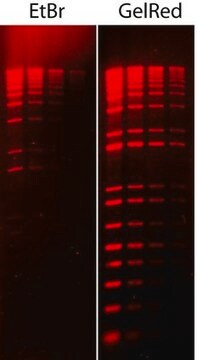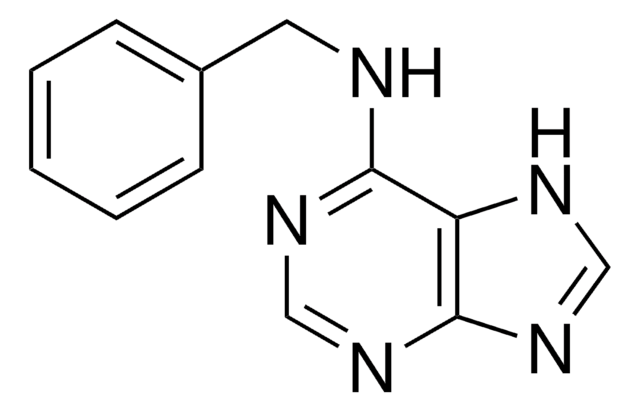N7161
Nogo-66(1-40) antagonist peptide
≥84% (HPLC)
Sinonimo/i:
NEP (1-40)
Autenticatiper visualizzare i prezzi riservati alla tua organizzazione & contrattuali
About This Item
Formula empirica (notazione di Hill):
C204H322N56O64 · xC2HF3O2
Peso molecolare:
4583.08 (free base basis)
Numero MDL:
Codice UNSPSC:
12352202
NACRES:
NA.32
Prodotti consigliati
Livello qualitativo
Saggio
≥84% (HPLC)
Forma fisica
lyophilized solid
Colore
white
Solubilità
H2O: 1 mg/mL
N° accesso UniProt
Temperatura di conservazione
−20°C
Informazioni sul gene
human ... RTN4(57142)
Amino Acid Sequence
Arg-Ile-Tyr-Lys-Gly-Val-Ile-Gln-Ala-Ile-Gln-Lys-Ser-Asp-Glu-Gly-His-Pro-Phe-Arg-Ala-Tyr-Leu-Glu-Ser-Glu-Val-Ala-Ile-Ser-Glu-Glu-Leu-Val-Gln-Lys-Tyr-Ser-Asn-Ser-NH2
Applicazioni
Nogo-66(1-40) antagonist peptide has been used as a Nogo-66 receptor antagonist peptide:
- to study the preliminary therapeutic effect after inhibition of Nogo-A in the cauda equina compression (CEC) model
- to determine the effects of Nogo-A/NgR1 on autophagic activation
- to study its role in Nogo-B mediated axonal branching using Schwann cells and sensory neurons of mice
Azioni biochim/fisiol
Myelin-derived axon outgrowth inhibitors, such as Nogo, may account for the lack of axonal regeneration in the central nervous system (CNS) after trauma in adult mammals. Nogo-66 can inhibit axonal outgrowth through an axonal Nogo-66 receptor (NgR). Competitive antagonists of NgR derived from amino-terminal peptide fragments of Nogo-66. The Nogo-66(1 40) antagonist peptide (NEP1 40) blocks Nogo-66 or CNS myelin inhibition of axonal outgrowth in vitro, demonstrating that NgR mediates a significant portion of axonal outgrowth inhibition by myelin. Intrathecal administration of NEP1 40 to rats with mid-thoracic spinal cord hemisection results in significant axon growth of the corticospinal tract, and improves functional recovery. Thus, Nogo-66 and NgR have central roles in limiting axonal regeneration after CNS injury, and NEP1-40 provides a potential therapeutic agent.
Note legali
Sold under a non-exclusive license. For research use only, and not for diagnostic or therapeutic use or for use in humans.
Codice della classe di stoccaggio
11 - Combustible Solids
Classe di pericolosità dell'acqua (WGK)
WGK 3
Punto d’infiammabilità (°F)
Not applicable
Punto d’infiammabilità (°C)
Not applicable
Dispositivi di protezione individuale
Eyeshields, Gloves, type N95 (US)
Certificati d'analisi (COA)
Cerca il Certificati d'analisi (COA) digitando il numero di lotto/batch corrispondente. I numeri di lotto o di batch sono stampati sull'etichetta dei prodotti dopo la parola ‘Lotto’ o ‘Batch’.
Possiedi già questo prodotto?
I documenti relativi ai prodotti acquistati recentemente sono disponibili nell’Archivio dei documenti.
Wei Xu et al.
Neuroscience, 431, 103-114 (2020-02-19)
Focal cerebral infarction leads to autophagic activation, which contributes to secondary neuronal damage in the ipsilateral thalamus. Although Nogo-A deactivation enhances neuronal plasticity, its role in autophagic activation in the thalamus after ischemic stroke remains unclear. This study aimed to
Tadzia GrandPré et al.
Nature, 417(6888), 547-551 (2002-05-31)
Myelin-derived axon outgrowth inhibitors, such as Nogo, may account for the lack of axonal regeneration in the central nervous system (CNS) after trauma in adult mammals. A 66-residue domain of Nogo (Nogo-66) is expressed on the surface of oligodendrocytes and
Neutralization of Nogo-A enhances synaptic plasticity in the rodent motor cortex and improves motor learning in vivo.
Zemmar A, Weinmann O, Kellner Y, et al.
The Journal of Neuroscience, 34(26), 8685-8698 (2014)
Xiaofei Sun et al.
Biochemical and biophysical research communications, 527(1), 131-137 (2020-05-25)
To investigate the expression of Nogo-A in dorsal root ganglion (DRG) in rats with cauda equina injury and the therapeutic effects of blocking Nogo-A and its receptor. Fifty-eight male Sprague-Dawley rats were divided randomly into either the sham operation group
Peng Zhai et al.
Biomedical materials (Bristol, England), 10(4), 045016-045016 (2015-08-05)
The adult mammalian central nervous system has limited ability to regenerate after injury. This is due, in part, to the presence of myelin-associated axon growth inhibitory proteins such as Nogo-A that bind and activate the Nogo receptor, leading to profound
Il team dei nostri ricercatori vanta grande esperienza in tutte le aree della ricerca quali Life Science, scienza dei materiali, sintesi chimica, cromatografia, discipline analitiche, ecc..
Contatta l'Assistenza Tecnica.








